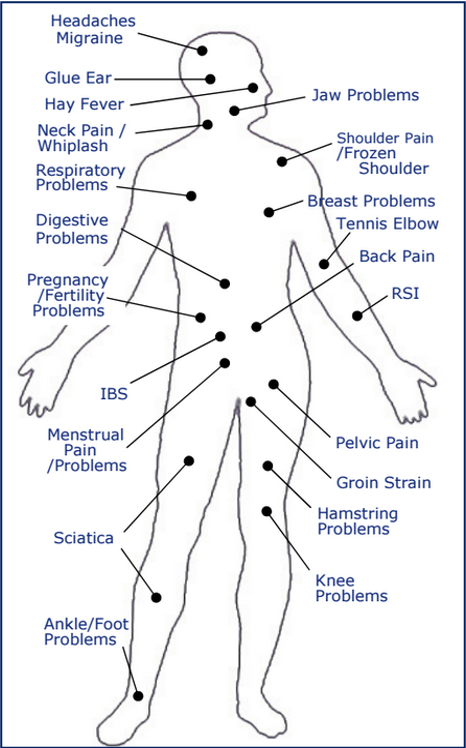
Bowen technique is a holistic, natural therapy which is hands on and relaxing. It is a non-invasive treatment which is given either directly on the skin or through light clothing. The therapist uses fingers or thumbs to move over muscle, ligament, tendon and fascia – just over soft tissue - in various parts of the body. It can be effective to help relieve everyday stresses and revitalise the whole person. There is no skeletal manipulation involved.
The first consultation is usually up to 1¼ hours, so that a comprehensive picture of the patient’s overall health, lifestyle, sleeping pattern and medical history can be established. This will be followed by an initial Bowen treatment of up to 30 minutes which is usually given on a couch; the client can also be treated in a chair if needed. Each Bowen therapy session varies according to the particular problems of the client.
Subsequent treatments will be approximately 1 hour.
For babies and children the time will be shorter, adjusted according to their needs.
Patients less than 18 need to be accompanied by an adult.
Most people find the treatment enjoyable and relaxing.
Treatment can be given either directly on the skin or through loose, light clothing so leggings, track suit, loose light trousers, T-shirts, etc. are ideal for this.
Helping to resolve pain and promote natural repair and healing, Bowen is known to help resolve a wide range of physical and/or emotional symptoms. These may well have come about due to recent, or old recurring injuries, stress, anxiety or other lifestyle pressures. A sense of wellbeing can be achieved, helping relaxation and aiding sleep.
It is safe for people of all ages - and physical conditions - from strong, fit adults, sportsmen and sportswomen to pregnant mums, babies, children, and even the elderly & frail.
Click here to go to the Fees page.
No, Bowen Practitioners do not diagnose conditions or alter any medication that their clients may be taking. They may recommend further assessment by a doctor in case medication needs to be adjusted, if appropriate. Bowen Technique is not intended as a substitute for medical advice or treatment, if you are in doubt, please consult your Doctor.
Most people find the treatment enjoyable and relaxing and Bowen therapists advise certain measures to optimise the body's ongoing response following the session. This includes the recommendation not to sit for more than 30 minutes at a time – just for the rest of the first day – so it is best not to make arrangements to visit the theatre, cinema, etc. that evening. You should also refrain from doing any strenuous exercise for 2-4 days after your visit (anything outside of your normal routine), or from any other treatment that could interfere with the ongoing Bowen process, such as physio, massage, acupuncture, osteopathy, etc. You will be given some after care instructions to take away with you to help you get the most out of your treatment.
This is a difficult question to answer as everyone is different; however, usually 2 or 3 treatments are required to bring about long term relief with acute problems, although many people experience relief after just 1 or 2 treatments. This may be immediately after the treatment or in the days that follow. Chronic, on-going conditions usually take longer but the relief is frequently apparent early on, often from conditions that have caused misery for years.
Ideally, the first two treatments should be 7 to 10 days apart.
Thomas Ambrose Bowen, the initiator of this therapy, was born in 1916 in Victoria, Australia. His parents had emigrated from Wolverhampton, England, and, in spite of never having had any formal medical training, developed the unique kind of Bodywork technique that is now known by his name. He possessed great insight, intuition and had a passion for how the body works.
In the early 1950s his day job was at the Geelong Cement Works as a general labourer and carpenter; he also worked with the local boys’ football team and as a swimming coach in his spare time, where he started to build a name for himself by successfully treating people with pain and injuries in the evenings and at the weekends. It was not unusual for people to be queued up on his front lawn into the night, waiting for treatment. He ran a free clinic for children with disabilities, twice a month on Saturday mornings, which was always a cause close to his heart. By the late 1950s Tom moved into full-time practice where he worked until his death in 1982. His technique was also effective on animals, dogs and horses in particular and Equestrian and Canine Bowen therapists are also to be found in ever growing numbers.
'Bowen therapy' or the 'Bowen technique' and other derivative / related styles based on the original Bowtech® interpretation include Fascial Kinetics, Neurostructural Integration Technique (NST), Smart Bowen and Fascia Bowen. These, along with complementary adjuncts such as Emmett Technique, are now delivered to an international public. It is a health modality offered by over 40,000 practitioners in some 59 countries or regions around the world, and is becoming more popular due to its success rates. Many people have found it through 'word of mouth' because of this fact.
